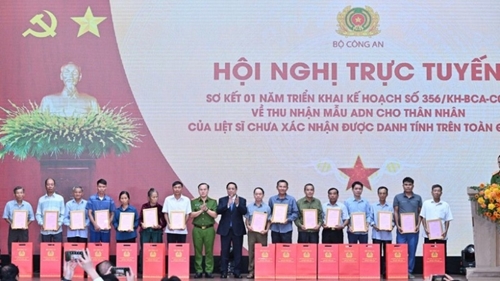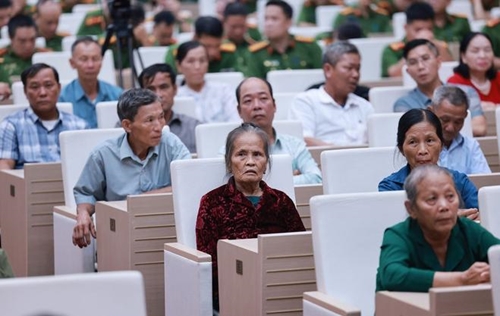So said Prime Minister Pham Minh Chinh while addressing a hybrid conference on July 25 reviewing the one-year implementation of a plan to collect DNA samples from relatives of unidentified martyrs nationwide.
    |
 |
|
PM Pham Minh Chinh presents the announcements of martyrs' DNA testing results to representatives of families at the conference on July 25. (Photo: VNA and nhandan.vn) |
On behalf of Party and State leaders, PM Pham Minh Chinh expressed deep gratitude to war heroes, martyrs, heroic Vietnamese mothers, wounded and sick soldiers, and martyrs’ relatives for their contributions as the country celebrate the 78th anniversary of the Wounded Soldiers and Martyrs’ Day (July 27, 1947 - 2025).
He emphasized that collecting DNA samples of unidentified martyrs’ relatives is a highly humanistic program that is “an order from the heart” and reflects the sense of responsibility towards the persons laying down their lives for the Fatherland’s independence and freedom, as well as the people’s happiness.
Appreciating efforts by public security and military forces, as well as people and businesses, to collect DNA samples, he said, “Compared to the sacrifices by martyrs and the contributions by their families, no matter how much we do, it is never enough!”
    |
 |
|
Representatives of martyrs' families attend the conference. |
Vietnam has more than 1.2 million martyrs in the struggles for national independence, freedom and reunification, as well as the noble international missions. Remains of over 900,000 martyrs have been repatriated, but about 300,000 are still unidentified. Meanwhile, there are about 652,000 wounded soldiers, 198,000 sick soldiers, 132,000 heroic Vietnamese mothers, and 320,000 individuals affected by Agent Orange/dioxin, he noted.
Therefore, the identification of martyrs is still an “urgent task,” especially amid impacts of time and weather, PM Pham Minh Chinh pointed out, stressing that DNA identification is not only to find out biological information but also key to recovering historical memories for their families, and connecting the past, the present, and the future.
The Party and State view the search for and repatriation of martyrs’ remains and their identification as an important and sacred duty of the entire political system and society. It requires utmost dedication, wisdom, technology application, compassion, industriousness, along with support from people and businesses, he noted.
The Government leader asked all-level authorities, sectors, localities, the whole political system, the Vietnam Fatherland Front, mass organizations, and people to join hands with the public security force to collect DNA samples of martyrs’ relatives. He also called for allocating budget and mobilizing private funding for the DNA analysis and sequencing.
He demanded stronger efforts to access every family of martyrs, especially those in remote, ethnic minority, and disadvantaged areas. Regular review and examination were urged to promptly address any problem arising.
Assigning tasks to ministries, localities, and organizations, PM Pham Minh Chinh described the application of DNA technology to martyr identification and the building of a martyr database and genetic bank as a big scientific and legal step to fulfil the duty.
After one year of implementing the Ministry of Public Security’s Plan No. 356/KH-BCA-C06, the ministry’s police department for administrative management of social order (C06) has coordinated with relevant sides to collect 57,273 DNA samples of heroic Vietnamese mothers and relatives of martyrs nationwide.
As of July 20, C06 had completed analyzing 11,138 samples of martyrs’ relatives. The samples were then transferred to laboratories for DNA sequencing and comparison with samples of martyrs’ remains.
Sixteen cases of martyrs’ DNA samples have been found to match the maternal relationship with the DNA samples of 27 martyrs’ relatives. C06 has worked with the Ministry of Home Affairs to complete procedures for recognizing the identities of these 16 martyrs.
Source: VNA